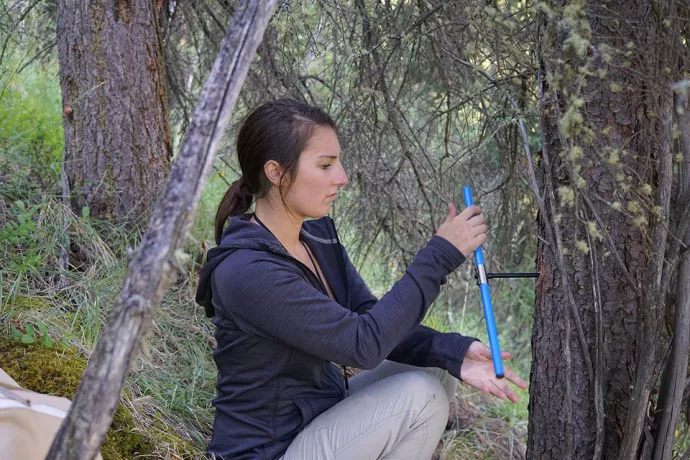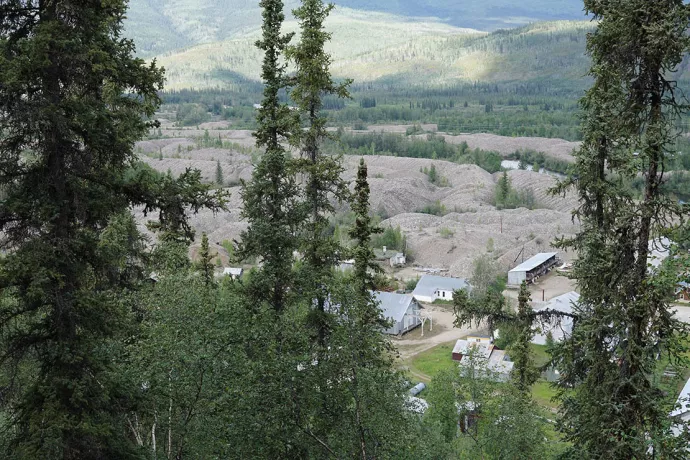UTM researchers use tree rings to measure Canadian Klondike-era mercury contamination

A U of T Mississauga research team has bored into the past, unlocking the secrets hidden beneath tree bark, to meticulously record the history of Klondike-era pollution – prompting a larger study of mercury contamination in the north.
Paleoclimatologist Trevor Porter, an assistant professor of geography who uses tree rings to understand past climate, recently combined his expertise with Igor Lehnherr, a fellow geography professor who studies contaminants, and UTM master’s student Sydney Clackett to investigate annual pollution levels at an old mining site in the Yukon. Their findings were recently published in Environmental Pollution.
Bear Creek, a busy gold mining town that operated from 1905 to 1966 just outside Dawson City, Yukon, was of particular interest to the team because it’s a “heavily polluted” area, Porter says. He explains that, following the Gold Rush, the large nuggets were stripped from the land and the only way to make money was to use heavy equipment, which required significant investments. The era of corporate gold mining started and, in the case of Bear Creek, it proved to be a big economic driver for the Yukon.
It also proved to be a source of local contamination.

One of the methods used in the past to extract gold from river gravel was to add mercury, which binds to the gold to help separate it from the sediment. The deposits were then heated to separate the gold and mercury. The process of burning off the mercury meant some of it was diffused into the atmosphere, where trees would “breath it in” during their growing season, Porter explains.
“Especially in the north, trees are growing in this really temperature-limited environment so we can look at the rings and almost interpret it like a climate record, going back in time,” he says.
Researchers took core samples from 15 trees growing in the area to see if the rings could provide a year-by-year account of atmospheric mercury levels created by past local mining operations. Core samples from an area unaffected by local mining operations were also collected as a control site.
Porter and his team found that the trees at Bear Creek not only hold a record of mercury levels, but those changes in levels match, precisely, the known activities at the site.
“We were just amazed when we saw this big spike in mercury take off, especially when operations at the site started expanding,” Porter says. “Trends on this site were just orders of magnitude greater than what was happening naturally.”
In 1923, for example, there was a merger of all major Klondike mining operations and more ore was brought to Bear Creek for processing. That year, researchers observed a “rocket ship” trend in their mercury data. Then, as operations started to wind down in the 1940s and 1950s, there’s a precipitous decline in mercury concentrations. The fastest rate of decline appears in 1966, when the site closed.
“I was amazed at how closely it corresponded to what we could gather from the historical record,” Porter says, adding this provides compelling evidence that this is a reliable method to track concentrations of local atmospheric mercury. “It elevates the idea that tree rings are an important archive for studying past changes in mercury.”

There’s not a lot of global data about changes to atmospheric mercury, Porter continues. There is some monitoring in highly urbanized areas, but that data only goes back about 30 years. UTM researchers, meanwhile, were able to analyze 151 years’ worth of data using tree rings.
While levels of mercury recorded at Bear Creek slowly came down to baseline levels, those baseline levels have been increasing over the past decade. Porter says that an uptick in atmospheric mercury has been observed in two other sites in the Yukon and Northwest Territories and has recently been confirmed by other records, including lake sediment in Alaska. That increase in mercury has been linked to rising emissions in Asia (mercury is not used in modern mining practices in Yukon).
Porter says there are international treaties to reduce mercury pollution and, while there’s been a lot of progress, “we know that’s not happening everywhere. Some still use dirty energy sources and other industries emit mercury.”
A larger network of sites is needed to better understand these regional increases and determine what is happening. Porter says he’s already developed additional sites in Yukon and the Northwest Territories.
“We’re scaling up our efforts to better understand recent trends in the environment,” Porter says.
Read more:



